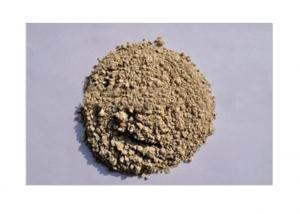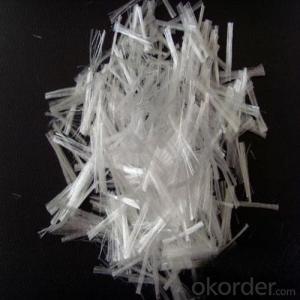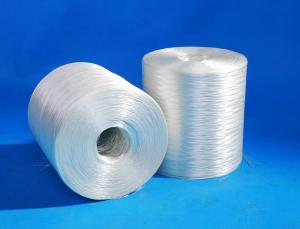Polypropylene Concrete Fiber
- Loading Port:
- China Main Port
- Payment Terms:
- TT or L/C
- Min Order Qty:
- 3000 Kgs kg
- Supply Capability:
- 100000 Tons Per Year kg/month
OKorder Service Pledge
OKorder Financial Service
You Might Also Like
Commodity: Industrial PP Fiber for Concrete, Engineering Fiber
PP fiber,also called Polypropylene PP Fiber, Polymer Fiber,it is manufactured by mixing, spinning, stretching and cutting the combination of modified base and polypropylene paring, used as the project fiber for concrete and mortar. It can decrease cracks in concrete's early stage.
Property:
| Polypropylene monofilament fiber technical | ||
| Item | Product name | PP fiber |
| 1 | Material | 100% polypropylene |
| 2 | Cut length | From 3mm to 120mm |
| 3 | density | 0.91g/cm³ |
| 4 | Diameter | 20 micron to 40micron |
| 5 | Strength | 400-600Mpa |
| 6 | elongation at break | 30%-40% |
| 7 | melting point | 170°C |
| 8 | ignition point | 590°C |
| 9 | Oil point | lower than 1% |
| 10 | Water-hygroscopicity | No |
Advantages of Polypropylene Concrete Fiber:
Good dispersancy, better grip
Random dispersal, subordination reinforced
Physically-added tendon, anti-crack and high reinforcement
Diamagnestism and antirust, corrosion protection and alkali resistant
Innocuous and odorless, safe
Simple operation, more economic and dependable
Function of Polypropylene Concrete Fiber:
Anti-crack
Increasing seepage-proof performance
Anti-concussion and anti-wear performance
Increasing shock proof
Cold-resistant property
Enhance the property of toughness and ductility
Fire resistance and anti-detonation quality
Preventing or reducing the major reinforcing steel bar from being eroded
Reducing rebound of jetting concrete
Application:
Industry and Civil Architecture
Main body of road, bridge
Water conservancy project
Package:
A: Packing in plastic bags, plastics bags to be put into waterproof bags, and then waterproof bags to be put into container, totally 8 tons in 1x20'FCL
B: Packing in fusible paper bags, paper bags to be put into cartons, and then cartons to be put into pallet, pallets to be put into container, totally 6 tons in 1x20'FCL.



- Q: teeth which was used to apply the braces. Can i get a cleaning a regular dentist remove the cement ot return to a orthodontist. I removed the braces cause I was young and moved far away from home. Boy do i regret that just because of this mess I have on my teeth.
- particular. a usual dentist can eliminate it for you. Do it ASAP so which you will sidestep added harm(tooth decay). do no longer wait or popping your braces off would be prepare for popping your fake tooth in and out. think of roughly it, the cement is protecting tooth floor meaning that part of the tooth isn't getting brushed.
- Q: I am buying a home and would like to 'dress up' the back patio area, but don't want to spend a fortune on tile for outdoors...was thinking about staining the front porch and back patio...but I don't know what this would entail...any help? THANKS!
- My bedroom floor is stained concrete. We ripped up the carpet in there, the living room and the front office/living area when we moved into our house. I also stained the back patio to look like terra cotta tiles. I loved my bedroom floor so much that even though we eventually put flooring down in the rest of the house I refuse to even consider it. The color I got at home depot is a sheer golden sun, we used an all purpose sprayer (the 2 gallon kind for bug spray) and then just layered it over the floor. Make sure the floor is clean or you will have a nightmare with dust or dirt residue. Then after you spray it, seal it with a clear cement sealer. You can do patterns, or a solid color, or make it look like stone. I have some very small rugs right by the bed on either side for warmth, but the staining effect looks great!
- Q: My basement shower is basically just a cement slab with a drain and fiberglass walls. What's a rough ballpark cost estimate to tear out the cement shower and replace it with a modern glass stall and/or a tile shower?
- By cement slab you refer to the concrete basement floor with a drain in it? Nothing to tear out. A contractor will install a shower pan. Either custom made or a prefab pan and tie into the existing drain. If you want to relocate the shower then he will jack hammer up the slab and run the drain. Save money by having the shower in the same place. For just the shower pan and walls framed, covered with backer board, tile tie into existing hot and cold water supply figure about $4000. If you want to use custom materials like granite and limestone tiles add $1000. Also plan to install an exhaust fan for the steam. If you can be happy with a prefab fiberglass surround it will be half the cost.
- Q: whats heavier when set up, cement or plaster?
- Cement-- concrete that is, a lot of bonding agents are also called cement-- is heavier, because the water stays in it when it is set. Plaster sets up with the water dried out of it.
- Q: Home house is rough room, the bathroom is gray walls, do not look good, would like to paste the waterproof stickers instead of tiles. Is it possible to do it? I look online, stickers need to be affixed to the smooth surface, can not be posted in the gray place. What should I do?
- If you want stickers, but the wall, and fall ash, then you go to the building materials market to sell wallpaper to buy a base film shop, 50% of the water brush to the wall, dry, want it It is impossible
- Q: I just bought this model and it's my first one doing it lol I was just curious that if after I painted one part and went to glue another onto the painted plastic, will it stick? Or will something else bad happen, or will it be perfectly fine? I just don't want to ruin it =( The glue I have is Testors Cement for Plastic Models and the paint is also Testors Enamel paint.
- The cement will probably dissolve the paint and you'll get a messy joint. Scrape the paint away at the places you want to glue.
- Q: its for my physics assignment..thanks!
- it absorb energy... such as heat..force or pressure ..
- Q: Looking for ideas on pouring a cement bartop?
- Make bowls in the cement for pretzels. How about having people write things in it when its wet? Maybe set in different types of wood, like cherry. How about small holes at the ends that lead to garbage cans.
- Q: There is water that seeps in when it rains hard near a pipe where the city water comes in. I already tried to use quot;Great Stuffquot; around the pipe and it didn't work. Do I just put hydraulic cement in the area around the pipe area, or do I have to do the whole wall? (Can you tell I'm a new homeowner?)
- Hydraulic cement is simply any portland based cement product that hardens when mixed with water. it is not necessarily waterproof just because it has the word hydraulic in its name. You should use an expanding waterproof epoxy grout for his purpose. It is available anywhere building products are sold. Follow container instructions. Work quickly. Most of these products harden in 10 or 15 minutes. As recommended by others here, make sure first that rainwater is being directed away from your foundation.
- Q: Poll: Rubber cement or School glue?
- Definitely rubber cement. It smells better and is much cooler. I love how it stays flexible and allows you to remove excess or misapplied rubber cement easily.
1. Manufacturer Overview
| Location | Shanxi, China |
| Year Established | 1982 |
| Annual Output Value | Above US$ 30 Million |
| Main Markets | 20.00% North America 20.00% South America 10.00% Eastern Europe 10.00% Southeast Asia 10.00% Northern Europe 10.00% South Asia 10.00% Western Europe 5.00% Africa 5.00% Mid East |
| Company Certifications | ISO9001:2000 |
2. Manufacturer Certificates
| a) Certification Name | |
| Range | |
| Reference | |
| Validity Period |
3. Manufacturer Capability
| a) Trade Capacity | |
| Nearest Port | Shanghai Port, China |
| Export Percentage | 41-50% |
| No.of Employees in Trade Department | 20-30 People |
| Language Spoken: | English; Chinese; |
| b) Factory Information | |
| Factory Size: | Above 50,000 square meters |
| No. of Production Lines | Above 10 |
| Contract Manufacturing | Design Service Offered; Buyer Label Offered |
| Product Price Range | High; Average |
Send your message to us
Polypropylene Concrete Fiber
- Loading Port:
- China Main Port
- Payment Terms:
- TT or L/C
- Min Order Qty:
- 3000 Kgs kg
- Supply Capability:
- 100000 Tons Per Year kg/month
OKorder Service Pledge
OKorder Financial Service
Similar products
Hot products
Hot Searches
Related keywords




























